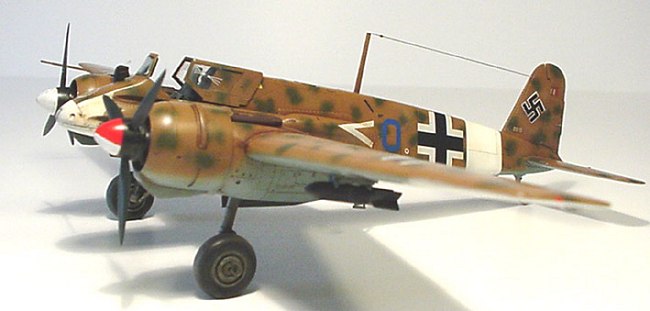
|
KIT # |
04523 |
|
PRICE: |
34 Swiss Francs |
|
DECALS: |
Two aircraft - no Swastikas |
|
REVIEWER: |
|
|
NOTES: |
Ex-Hasegawa mold. Built OOB |

|
HISTORY |
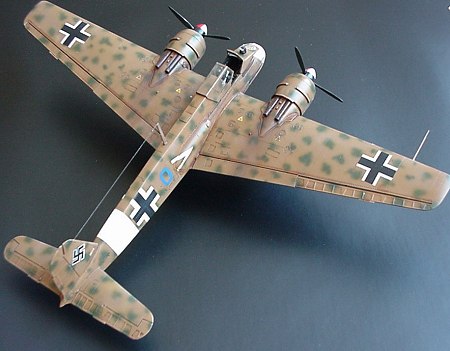 The Henschel prototype, Hs 129
V-1, first flew on 26 may 1939 and quickly outclassed its competitor, the
Focke-Wulf 189 S. The first series aircraft, Hs 129 A-0 – produced in the
summer of 1940 and powered by Argus As-410 motors had no success with its
pilots due to its lack of power and poor cockpit visibility, and was
eventually relegated to training units. As a new motor had to be found,
and the German industry couldn’t follow the demand, a solution was found
by fitting the second version – Hs 129 B – with “war booty” French Gnome
& Rhône 14M motors (the same that powered the Breguet 693 attack
aircraft), that were available in large numbers after the invasion of
France. The armoured canopy was redesigned to give the pilot slightly
better vision.
The Henschel prototype, Hs 129
V-1, first flew on 26 may 1939 and quickly outclassed its competitor, the
Focke-Wulf 189 S. The first series aircraft, Hs 129 A-0 – produced in the
summer of 1940 and powered by Argus As-410 motors had no success with its
pilots due to its lack of power and poor cockpit visibility, and was
eventually relegated to training units. As a new motor had to be found,
and the German industry couldn’t follow the demand, a solution was found
by fitting the second version – Hs 129 B – with “war booty” French Gnome
& Rhône 14M motors (the same that powered the Breguet 693 attack
aircraft), that were available in large numbers after the invasion of
France. The armoured canopy was redesigned to give the pilot slightly
better vision.
The Henschel 129 (the most numerous version being the B-2) entered combat in may 1942, and served mainly on the eastern front with great efficiency, its heavy armament of two 7.92 machine guns, two 20mm cannons, bombs, and a 30mm MK 101 or 103 cannon in a ventral gondola wreaking havoc among the soviet armoured regiments. The Rumanian Air Force made an extensive use of Hs 129s, too, eventually turning them against the Germans after the 23 august 1944 armistice. The ultimate version, Hs 129 B-3 – armed with a heavy 75mm antitank gun, entered service too late to be of any help (the fact if it was ever used in combat being questioned by some authors).
As for the version I built, it’s another story… In November of 1942, two units of Hs 129’s were sent to Tunisia to provide air support to Rommel’s Afrika Korps that was in a desperate situation. For the first few days, everything went fine, and the new German plane created a real panic among the British tank units. Unfortunately for the Luftwaffe, the Gnome-Rhône motor was extremely sensible to desert sand, and after three weeks, the whole Geschwader was out of business… Thus ended the short career of the Henschel 129 in North Africa.
|
THE KIT |
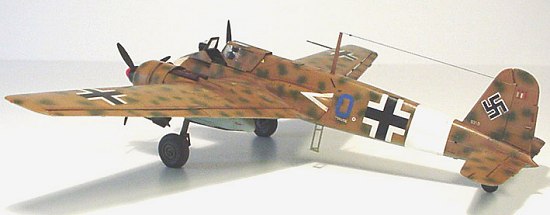 What you find in the soft,
side-opening Revell box is the excellent Hasegawa kit first released a
few years ago. The price being almost half of what it used to be (in
Europe at least), the poor packaging isn’t a problem. The quality is
exactly what is expected from Hasegawa : precise moulding, exquisite
recessed panel lines, fine details. The decals provided by Revell include
two versions : Hauptmann Ruffer’s famous red G with the classic 70/71
camo, and blue O from 5/Sch.G.(Schlachtgeschwader – Battle group) 1 in
Tunisia (the unit having been sent there from the eastern front, this
machine carries red star victory marks on the fin). As I wanted to test
my new Harder & Steenbeck “Focus” airbrush, the mottled ship was an
obvious choice…
What you find in the soft,
side-opening Revell box is the excellent Hasegawa kit first released a
few years ago. The price being almost half of what it used to be (in
Europe at least), the poor packaging isn’t a problem. The quality is
exactly what is expected from Hasegawa : precise moulding, exquisite
recessed panel lines, fine details. The decals provided by Revell include
two versions : Hauptmann Ruffer’s famous red G with the classic 70/71
camo, and blue O from 5/Sch.G.(Schlachtgeschwader – Battle group) 1 in
Tunisia (the unit having been sent there from the eastern front, this
machine carries red star victory marks on the fin). As I wanted to test
my new Harder & Steenbeck “Focus” airbrush, the mottled ship was an
obvious choice…
|
CONSTRUCTION |
Construction was pretty straightforward,
as usual with Hasegawa kits, the only flaws being some slight assembly
inaccuracies due to the aircraft’s complicated shape. Some putty was
needed on the fuselage seams and the motor cowlings, which means that I
had to rescribe some panel lines after the sanding operations. In order
to make painting easier, I treated the motors separately. Be cautious
with the ailerons, as they break loose very easily. I recommend to paint
them 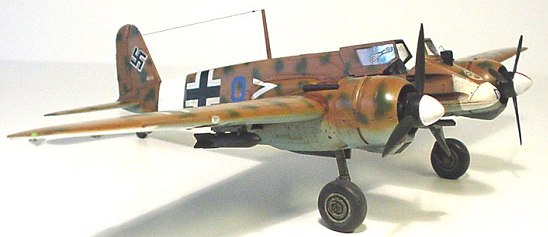 aside and install them after the model is finished. The cockpit
being very small and well detailed, I think no aftermarket parts are
needed here. The wheels are also excellent – and in “weighted” condition
– not a kit for resin providers also.
aside and install them after the model is finished. The cockpit
being very small and well detailed, I think no aftermarket parts are
needed here. The wheels are also excellent – and in “weighted” condition
– not a kit for resin providers also.
Transparencies are very thin and clear. The sliding canopy covering a part of the fuselage, the better solution is to paint the kit first and install it afterwards. Due to their simple form, masking the windows is quite easy. Fine decals are provided to represent the white lines painted on the canopy sides to help the pilot estimate his angle of dive.
The armament provided includes both MK 101 and 103 cannons (don’t mix up the different gondolas !), plus two SC-50 bombs on underwing racks. No documentation being available on this subject, I chose the MK 103 because its square muzzle brake and anti-vibration barrel ring look “funnier” than the more classic MK 101. Two different types of exhaust pipes (early and late model) are also provided. Make sure to pick the right ones (I had to change mine…). An antenna mast is included for the early B-2. Decals represent the externally installed motor instrument panels (the cockpit being so cramped).
|
CAMOUFLAGE & MARKINGS |
The aircraft is painted in a 79
(sand) camo with 80 (olive green) mottles, the under surfaces being 78
light blue. White Mediterranean front markings are displayed on the nose
(quite a tricky masking job), the rear fuselage (a decal is provided ,
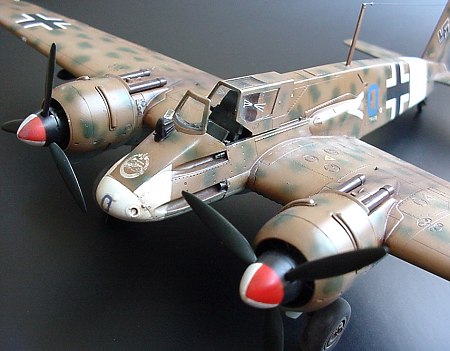 but I didn’t use it) and the outer under wing panels. According to the
few available pictures, the mottling job should not be too dense. Except
for the aforementioned victory marks and the quite usual infantry assault
insignia -in this case a “tank destroyer” badge- adorning the nose, no
personal or unit markings are carried. After a little training, the
“Focus” airbrush worked wonder on that camouflage. I recommend this fine
tool to everyone. As usual, Tamiya acrylics were used (and self-mixed to
match the paint chips in Monogram’s book “German camouflage colours”).
The most difficult part of the painting job was the three-colour
spinners.
but I didn’t use it) and the outer under wing panels. According to the
few available pictures, the mottling job should not be too dense. Except
for the aforementioned victory marks and the quite usual infantry assault
insignia -in this case a “tank destroyer” badge- adorning the nose, no
personal or unit markings are carried. After a little training, the
“Focus” airbrush worked wonder on that camouflage. I recommend this fine
tool to everyone. As usual, Tamiya acrylics were used (and self-mixed to
match the paint chips in Monogram’s book “German camouflage colours”).
The most difficult part of the painting job was the three-colour
spinners.
After applying a protective gloss acrylic lacquer, I put on the decals (they went on fine, with no silvering, and they cover quite well). Then, brushed an oil wash of terracotta (easy on the weathering, these planes served only for three weeks !), and sprayed a few layers of Micro Flat matt varnish (my new airbrush’s narrow muzzle doesn’t stand flat acrylic lacquers anymore – I had to find something new…). A little pastel powder to represent gunpowder and exhaust stains as well as tire wear gave the final touch.
|
CONCLUSIONS |
 It was fun to build this excellent kit. I
always liked the aggressive and typical “teutonic” look of the Henschel
129 (to me, it’s also the real “father” of the A-10 Thunderbolt II –
another “ugly bird with a punch”) , and Hasegawa/Revell’s issue is a
great improvement compared to the old Esci kit. Considering the superb
Revell/Italeri 1/72 models (not forgetting Pavla’s nice Hs 129 A), I can
say we now have a complete and accurate range of kits doing full justice
to this lesser known, yet important and fascinating aircraft. Some day
I’ll build a Rumanian !
It was fun to build this excellent kit. I
always liked the aggressive and typical “teutonic” look of the Henschel
129 (to me, it’s also the real “father” of the A-10 Thunderbolt II –
another “ugly bird with a punch”) , and Hasegawa/Revell’s issue is a
great improvement compared to the old Esci kit. Considering the superb
Revell/Italeri 1/72 models (not forgetting Pavla’s nice Hs 129 A), I can
say we now have a complete and accurate range of kits doing full justice
to this lesser known, yet important and fascinating aircraft. Some day
I’ll build a Rumanian !
PS :To those who find it too angular and bulky, I’d just like to say that here in Europe the Henschel company has always been – and still is - famous for making fine… trucks.
|
REFERENCES |
Squadron Signal: “Henschel 129 in Action”, Monogram: “German camouflage colours”.
July 2003
If you would like your product reviewed fairly and quickly by a site that has over 200,000 visitors a month, please contact me or see other details in the Note to Contributors.